高中英语优秀教案(英文模板)Teaching plan
- 格式:doc
- 大小:45.00 KB
- 文档页数:2
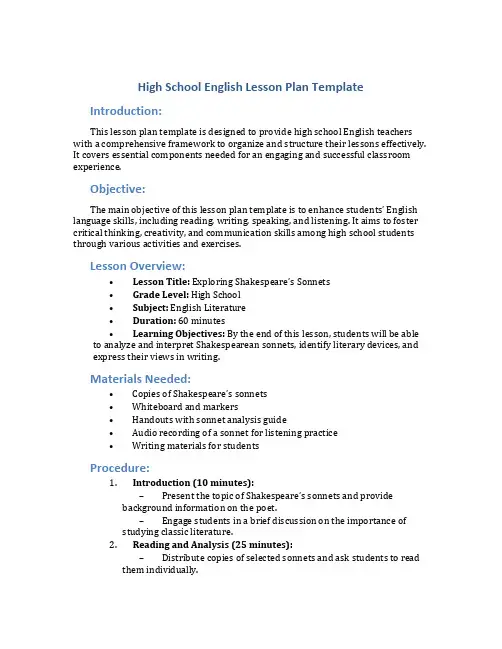
High School English Lesson Plan Template Introduction:This lesson plan template is designed to provide high school English teachers with a comprehensive framework to organize and structure their lessons effectively. It covers essential components needed for an engaging and successful classroom experience.Objective:The main objective of this lesson plan template is to enhance students’ English language skills, including reading, writing, speaking, and listening. It aims to foster critical thinking, creativity, and communication skills among high school students through various activities and exercises.Lesson Overview:•Lesson Title:Exploring Shakespeare’s Sonnets•Grade Level: High School•Subject: English Literature•Duration: 60 minutes•Learning Objectives: By the end of this lesson, students will be able to analyze and interpret Shakespearean sonnets, identify literary devices, and express their views in writing.Materials Needed:•Copies of Shakespeare’s sonnets•Whiteboard and markers•Handouts with sonnet analysis guide•Audio recording of a sonnet for listening practice•Writing materials for studentsProcedure:1.Introduction (10 minutes):–Present the topic of Shakespeare’s sonnets and provide background information on the poet.–Engage students in a brief discussion on the importance of studying classic literature.2.Reading and Analysis (25 minutes):–Distribute copies of selected sonnets and ask students to read them individually.–Encourage students to identify literary devices such as rhyme, metaphor, and imagery.–Guide students in analyzing the themes and main ideas of the sonnets.3.Listening Activity (10 minutes):–Play an audio recording of a sonnet for students to listen carefully.–Ask students to note the tone, mood, and emotions conveyed in the sonnet.4.Discussion and Group Work (15 minutes):–Divide students into groups and assign each group a different sonnet to analyze and present to the class.–Facilitate group discussions and provide guidance as needed.–Encourage students to collaborate and share theirinterpretations.5.Writing Task (10 minutes):–Assign a writing task that requires students to compose a short essay or reflection on a chosen sonnet.–Provide writing prompts and guidelines to support students in their writing.Assessment:•Formative Assessment: Observation of student participation in discussions and group work, analysis of written reflections.•Summative Assessment:Evaluation of students’ understanding of Shakespearean sonnets through written assignments and quizzes.Conclusion:This lesson plan template serves as a valuable resource for high school English teachers to create engaging and interactive lessons on Shakespearean sonnets. By following this structured framework, teachers can effectively guide students in exploring the rich language and themes of classic literature.。
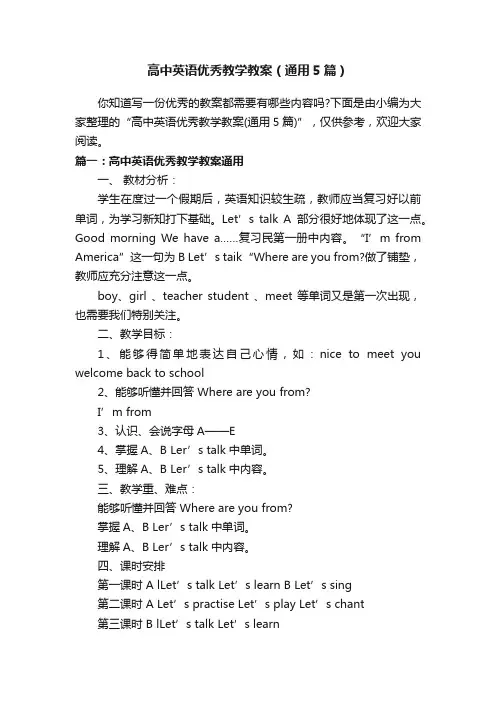
高中英语优秀教学教案(通用5篇)你知道写一份优秀的教案都需要有哪些内容吗?下面是由小编为大家整理的“高中英语优秀教学教案(通用5篇)”,仅供参考,欢迎大家阅读。
篇一:高中英语优秀教学教案通用一、教材分析:学生在度过一个假期后,英语知识较生疏,教师应当复习好以前单词,为学习新知打下基础。
Let’s talk A部分很好地体现了这一点。
Good morning We have a……复习民第一册中内容。
“I’m from America”这一句为B Let’s taik“Where are you from?做了铺垫,教师应充分注意这一点。
boy、girl 、teacher student 、meet等单词又是第一次出现,也需要我们特别关注。
二、教学目标:1、能够得简单地表达自己心情,如:nice to meet you welcome back to school2、能够听懂并回答 Where are you from?I’m from3、认识、会说字母A——E4、掌握A、B Ler’s talk中单词。
5、理解A、B Ler’s talk中内容。
三、教学重、难点:能够听懂并回答 Where are you from?掌握A、B Ler’s talk中单词。
理解A、B Ler’s talk中内容。
四、课时安排第一课时A lLet’s talk Let’s learn B Let’s sing第二课时A Let’s practise Let’s play Let’s chant第三课时B lLet’s talk Let’s learn第四课时BLet’ssay Let’spractise第五课时B Let’s Let’s第六课时 C story time篇二:高中英语优秀教学教案通用教学目标1、引导学生通过上下文理解生词的含义:anecdote, annual, witness, accommodation, shore, yell, pack, flee, drag, depth, lip, tongue, abandon, relationship, help out2、帮助学生掌握文中一些描述事物和情景的生动手法,从而体会作者的思想情感,把握文章的精髓。
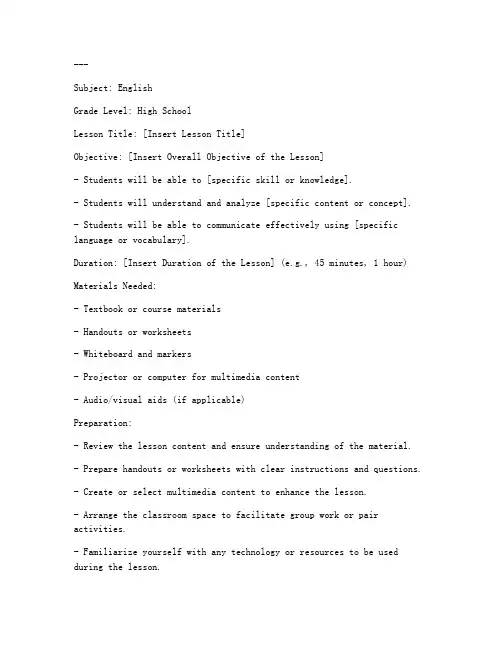
Subject: EnglishGrade Level: High SchoolLesson Title: [Insert Lesson Title]Objective: [Insert Overall Objective of the Lesson]- Students will be able to [specific skill or knowledge].- Students will understand and analyze [specific content or concept].- Students will be able to communicate effectively using [specific language or vocabulary].Duration: [Insert Duration of the Lesson] (e.g., 45 minutes, 1 hour) Materials Needed:- Textbook or course materials- Handouts or worksheets- Whiteboard and markers- Projector or computer for multimedia content- Audio/visual aids (if applicable)Preparation:- Review the lesson content and ensure understanding of the material. - Prepare handouts or worksheets with clear instructions and questions. - Create or select multimedia content to enhance the lesson.- Arrange the classroom space to facilitate group work or pair activities.- Familiarize yourself with any technology or resources to be used during the lesson.Warm-Up (5 minutes)Activity: [Insert Warm-Up Activity]- Purpose: To engage students and activate prior knowledge.- Procedures:1. Begin with a brief discussion or question related to the lesson topic.2. Have students share their thoughts or experiences.3. Transition smoothly into the main part of the lesson.---Introduction (10 minutes)Activity: [Insert Introduction Activity]- Purpose: To introduce the lesson topic and objectives.- Procedures:1. Briefly introduce the topic using a hook (e.g., a question, a video clip, a picture).2. Clearly state the lesson objectives and expectations.3. Provide a brief overview of the lesson structure.---Main Content (25 minutes)Activity 1: [Insert Activity 1]- Purpose: To introduce new vocabulary or concepts.- Procedures:1. Present the new vocabulary or concepts through visual aids, examples, or explanations.2. Have students practice using the new language through interactive activities or exercises.3. Provide feedback and clarification as needed.Activity 2: [Insert Activity 2]- Purpose: To reinforce understanding and application of the new content.- Procedures:1. Conduct a group activity or pair work to apply the new knowledge.2. Provide guidance and support as students work together.3. Encourage students to share their findings or responses.Activity 3: [Insert Activity 3]- Purpose: To deepen understanding and critical thinking.- Procedures:1. Engage students in a discussion or debate related to the lesson topic.2. Use questioning techniques to encourage higher-order thinking.3. Summarize key points and provide additional information if necessary.---Conclusion (5 minutes)Activity: [Insert Conclusion Activity]- Purpose: To review the lesson and reinforce learning.- Procedures:1. Summarize the main points covered in the lesson.2. Ask students to share their learning or reflections.3. Assign homework or provide additional resources for further learning.---Homework Assignment:- [Insert Homework Assignment]- Purpose: To reinforce learning and provide additional practice.---Assessment:- [Insert Assessment Methods]- Purpose: To evaluate student understanding and achievement of the lesson objectives.---Reflection:- [Insert Reflection Questions]- Purpose: To encourage self-assessment and reflection on the lesson.---This template provides a structured outline for creating a high school English lesson plan. Adjust the activities, duration, and materials as needed to fit the specific requirements of your curriculum and student needs.。
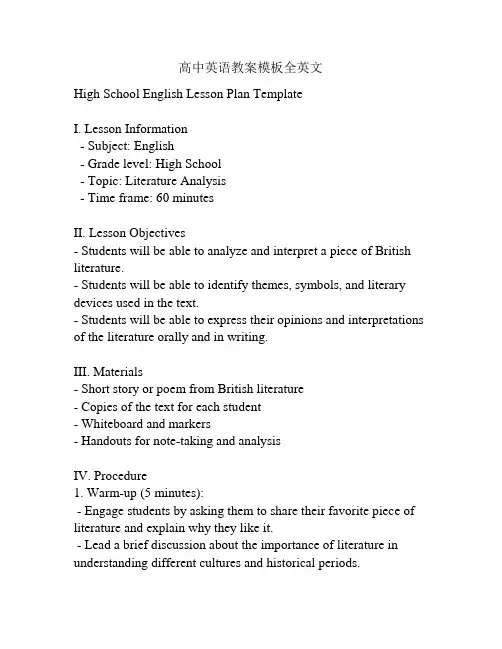
高中英语教案模板全英文High School English Lesson Plan TemplateI. Lesson Information- Subject: English- Grade level: High School- Topic: Literature Analysis- Time frame: 60 minutesII. Lesson Objectives- Students will be able to analyze and interpret a piece of British literature.- Students will be able to identify themes, symbols, and literary devices used in the text.- Students will be able to express their opinions and interpretations of the literature orally and in writing.III. Materials- Short story or poem from British literature- Copies of the text for each student- Whiteboard and markers- Handouts for note-taking and analysisIV. Procedure1. Warm-up (5 minutes):- Engage students by asking them to share their favorite piece of literature and explain why they like it.- Lead a brief discussion about the importance of literature in understanding different cultures and historical periods.2. Introduction (10 minutes):- Introduce the selected short story or poem, providing background information about the author and the time period in which it was written.- Display the title and author on the board.- Write the following questions on the board to guide the students' analysis: What themes can you identify in the text? Are there any significant symbols or metaphors? What literary devices are used? How does this piece of literature reflect the historical context?3. Reading and Analysis (30 minutes):- Distribute copies of the text to each student.- Allow students time to read the text silently and take notes on the provided handouts.- Divide the class into small groups and encourage them to discuss their initial thoughts and interpretations of the literature.- Circulate among the groups to answer questions and provide guidance as needed.- Reconvene as a whole class and facilitate a group discussion, encouraging students to share their interpretations, identify themes, symbols, and literary devices, and support their ideas with evidence from the text.4. Writing Task (10 minutes):- Assign a writing task that requires students to analyze and interpret the literature in a short essay or response.- Provide guidelines for the writing task, including the length, structure, and specific questions to address.5. Closure (5 minutes):- Review the main points discussed during the lesson, highlighting the importance of literary analysis and interpretation.- Allow students to ask any remaining questions or share any final thoughts.- Encourage students to continue exploring literature from different cultures and time periods.V. Assessment- Assess students' understanding and analysis of the literature through their participation in the group discussion and their written responses.- Provide constructive feedback on their interpretations and writing skills.- Assess students' ability to support their ideas with evidence from the text and their ability to engage in constructive dialogue with their peers.。
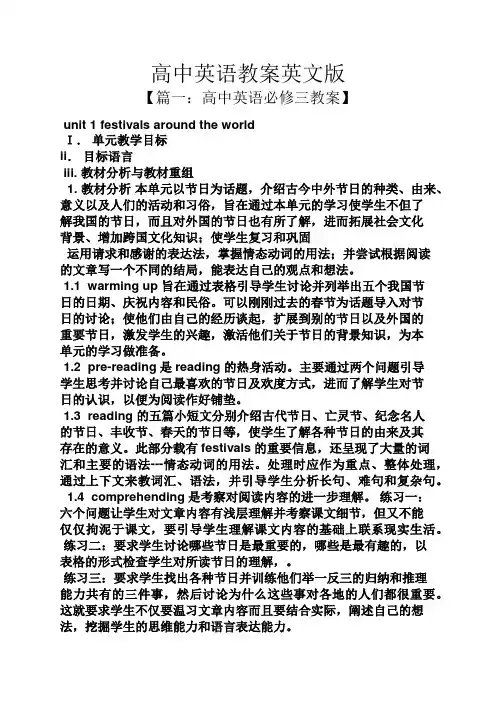
高中英语教案英文版【篇一:高中英语必修三教案】unit 1 festivals around the worldI.单元教学目标ii.目标语言iii. 教材分析与教材重组1. 教材分析本单元以节日为话题,介绍古今中外节日的种类、由来、意义以及人们的活动和习俗,旨在通过本单元的学习使学生不但了解我国的节日,而且对外国的节日也有所了解,进而拓展社会文化背景、增加跨国文化知识;使学生复习和巩固运用请求和感谢的表达法,掌握情态动词的用法;并尝试根据阅读的文章写一个不同的结局,能表达自己的观点和想法。
1.1 warming up 旨在通过表格引导学生讨论并列举出五个我国节日的日期、庆祝内容和民俗。
可以刚刚过去的春节为话题导入对节日的讨论;使他们由自己的经历谈起,扩展到别的节日以及外国的重要节日,激发学生的兴趣,激活他们关于节日的背景知识,为本单元的学习做准备。
1.2 pre-reading是reading 的热身活动。
主要通过两个问题引导学生思考并讨论自己最喜欢的节日及欢度方式,进而了解学生对节日的认识,以便为阅读作好铺垫。
1.3 reading 的五篇小短文分别介绍古代节日、亡灵节、纪念名人的节日、丰收节、春天的节日等,使学生了解各种节日的由来及其存在的意义。
此部分载有festivals的重要信息,还呈现了大量的词汇和主要的语法---情态动词的用法。
处理时应作为重点、整体处理,通过上下文来教词汇、语法,并引导学生分析长句、难句和复杂句。
1.4 comprehending是考察对阅读内容的进一步理解。
练习一:六个问题让学生对文章内容有浅层理解并考察课文细节,但又不能仅仅拘泥于课文,要引导学生理解课文内容的基础上联系现实生活。
练习二:要求学生讨论哪些节日是最重要的,哪些是最有趣的,以表格的形式检查学生对所读节日的理解,。
练习三:要求学生找出各种节日并训练他们举一反三的归纳和推理能力共有的三件事,然后讨论为什么这些事对各地的人们都很重要。
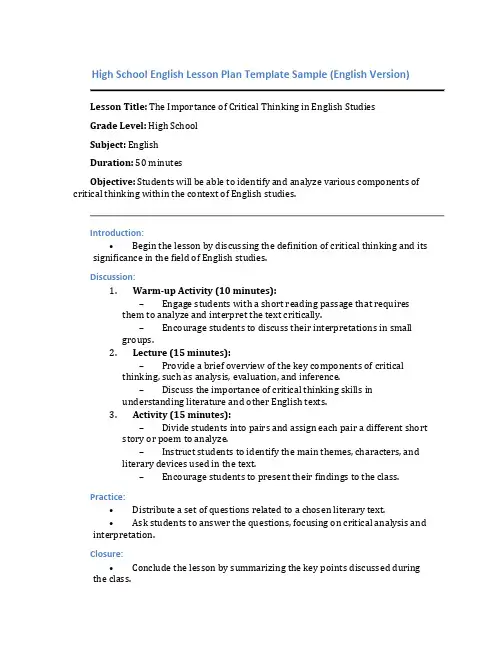
High School English Lesson Plan Template Sample (English Version)Lesson Title: The Importance of Critical Thinking in English StudiesGrade Level: High SchoolSubject: EnglishDuration: 50 minutesObjective: Students will be able to identify and analyze various components of critical thinking within the context of English studies.Introduction:•Begin the lesson by discussing the definition of critical thinking and its significance in the field of English studies.Discussion:1.Warm-up Activity (10 minutes):–Engage students with a short reading passage that requires them to analyze and interpret the text critically.–Encourage students to discuss their interpretations in small groups.2.Lecture (15 minutes):–Provide a brief overview of the key components of critical thinking, such as analysis, evaluation, and inference.–Discuss the importance of critical thinking skills inunderstanding literature and other English texts.3.Activity (15 minutes):–Divide students into pairs and assign each pair a different short story or poem to analyze.–Instruct students to identify the main themes, characters, and literary devices used in the text.–Encourage students to present their findings to the class.Practice:•Distribute a set of questions related to a chosen literary text.•Ask students to answer the questions, focusing on critical analysis and interpretation.Closure:•Conclude the lesson by summarizing the key points discussed during the class.•Encourage students to continue practicing their critical thinking skills in future English studies.Assessment:•Assess students based on their participation in the group discussions, ability to analyze literary texts critically, and responses to the practicequestions.Homework:•Assign students a reading assignment that requires them to apply critical thinking skills to analyze a selected piece of literature.This lesson plan template aims to guide high school English teachers in designing engaging and effective lessons that promote critical thinking skills among students. By incorporating various activities and discussions, students can enhance their ability to analyze and interpret English texts more effectively.。
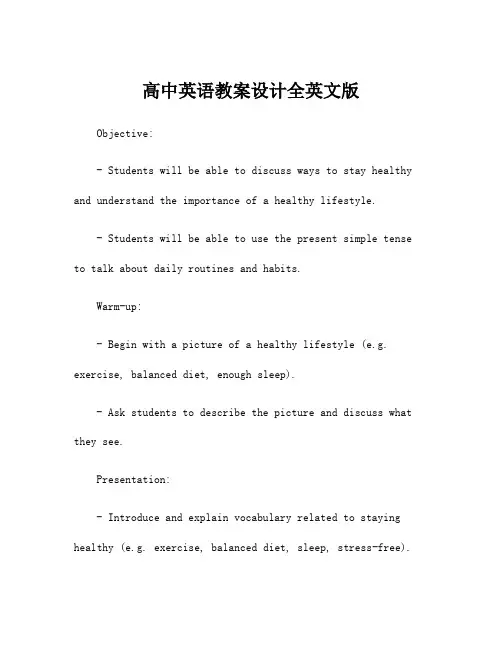
高中英语教案设计全英文版Objective:- Students will be able to discuss ways to stay healthy and understand the importance of a healthy lifestyle.- Students will be able to use the present simple tense to talk about daily routines and habits.Warm-up:- Begin with a picture of a healthy lifestyle (e.g. exercise, balanced diet, enough sleep).- Ask students to describe the picture and discuss what they see.Presentation:- Introduce and explain vocabulary related to staying healthy (e.g. exercise, balanced diet, sleep, stress-free).- Show pictures or short video clips to illustrate each concept.Practice:- Group students into pairs or small groups and have them discuss their daily routines and habits related to staying healthy.- Elicit responses from each group and provide feedback on the use of vocabulary and grammar.Production:- In pairs, students will create a short dialogue about a healthy lifestyle, incorporating the vocabulary and grammar discussed in class.- Randomly select a few pairs to perform their dialogues in front of the class.Conclusion:- Review the key concepts and vocabulary related to staying healthy.- Assign homework to have students write a short paragraph about their own healthy habits and routines.。
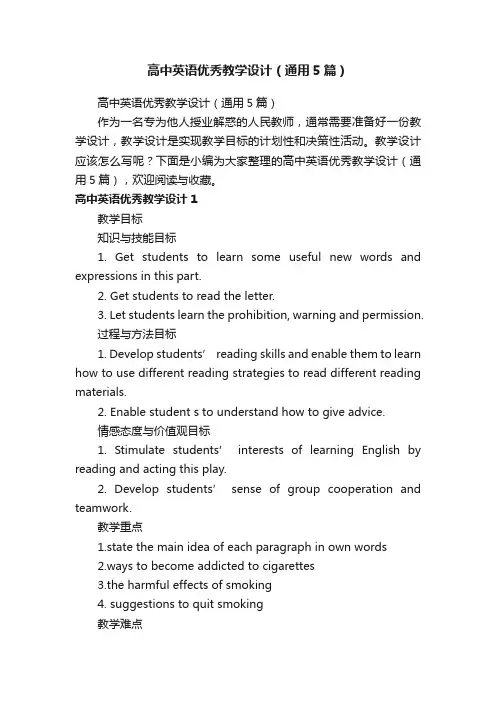
高中英语优秀教学设计(通用5篇)高中英语优秀教学设计(通用5篇)作为一名专为他人授业解惑的人民教师,通常需要准备好一份教学设计,教学设计是实现教学目标的计划性和决策性活动。
教学设计应该怎么写呢?下面是小编为大家整理的高中英语优秀教学设计(通用5篇),欢迎阅读与收藏。
高中英语优秀教学设计1教学目标知识与技能目标1. Get students to learn some useful new words and expressions in this part.2. Get students to read the letter.3. Let students learn the prohibition, warning and permission.过程与方法目标1. Develop students’ reading skills and enable them to learn how to use different reading strategies to read different reading materials.2. Enable student s to understand how to give advice.情感态度与价值观目标1. Stimulate students’ interests of learning English by reading and acting this play.2. Develop students’ sense of group cooperation and teamwork.教学重点1.state the main idea of each paragraph in own words2.ways to become addicted to cigarettes3.the harmful effects of smoking4. suggestions to quit smoking教学难点1. sorting out major idea and minor idea2. master key words in key sentence教学过程→Step 1 Warming upShow some proverbs on health1.An apple a day keeps the doctor away.2.Early to bed and early to rise, makes a man healthy, wealthy and wise.→Step 2 Skimming1How many parts does the reading text consist of?2. Who wrote the letter to whom?3. How many ways can a man become addicted to smoking?→Step 3 Scanning1. The first sentence of the letter shows James granddad______ .A. lives a healthy lifeB. is addicted to sitting in the gardenC. has nothing to do at homeD. is tired when cycling 20 kilometers2. From the second paragraph, we can know granddad ______________.A . never smoked B. likes smokingC. used to smoke heavilyD. still smokes now→Step 4 Detailed readingAsk students to discuss the following questions in pairs.(让学生分组讨论,形成书面形式)1.Different ways people can become addicted to cigarettes.2. Harmful effects for smokers吸烟的危害3.ways to quit smoking→Step 5 Post readingWrite some advice to persuade smokers to quit smoking→Step6 DiscussionHow to live a healthy life?→Step 7 Homework1. write down the suggestions given by granddad2. try to persuade one to give up smoking高中英语优秀教学设计2一、说教材本单元主要是围绕生日展开教学,要求学生掌握十二个月份和序数词的变化,以及日期和生日的表达。
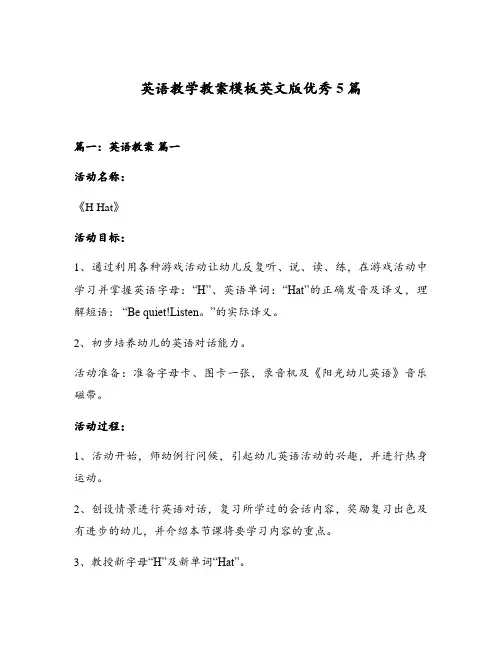
英语教学教案模板英文版优秀5篇篇一:英语教案篇一活动名称:《H Hat》活动目标:1、通过利用各种游戏活动让幼儿反复听、说、读、练,在游戏活动中学习并掌握英语字母:“H”、英语单词:“Hat”的正确发音及译义,理解短语:“Be quiet!Listen。
”的实际译义。
2、初步培养幼儿的英语对话能力。
活动准备:准备字母卡、图卡一张,录音机及《阳光幼儿英语》音乐磁带。
活动过程:1、活动开始,师幼例行问候,引起幼儿英语活动的兴趣,并进行热身运动。
2、创设情景进行英语对话,复习所学过的会话内容,奖励复习出色及有进步的幼儿,并介绍本节课将要学习内容的重点。
3、教授新字母“H”及新单词“Hat”。
(1)教师出示字母娃娃H,让幼儿说出像什么,在拼贴字母的过程中学会字母“H”的正确发音。
(2)教师利用图卡引出“帽子”的英语单词,通过游戏“贴帽子”让幼儿反复练习强化,逐渐掌握单词“Hat”的正确发音及译义。
4、律动教学。
教授幼儿短语“Be quiet!Listen。
”的实际译义及相应的动作。
5、教师小结,叮嘱幼儿:“回家要看VCD,回家要听录音机,回家要当Melody!”篇二:高中英语教学设计篇二一、课程类型:高三复习课二、教学目标:一) 认知目标1、句型和语言点(见教学重点)。
2、用所学的知识与伙伴进行交流、沟通,学会改错、写作。
二)情感目标利用多媒体手段营造积极和谐教学氛围,使学生不自觉地进入情景之中,充分调动学生的思维活动和情感体验,引起学生的共鸣。
三)智力目标在运用语言的过程中培养学生的观察力、分析力、想象力和自学能力,帮助学生加强记忆力,提高思维能力和运用英语的综合能力,激发创造能力。
三、教材分析:这是高三复习阶段的一节写作课。
这节书面表达课就从审题谋篇等方面入手来完成教学目的,侧重于引导学生在把握书面表达的写作前准备即谋篇审题能力,使学生在动手写作前迅速构思按照规范的模式来完成谋篇审题:在教学中不仅仅强调写,对于与写作紧密联系的听、说、读、改错都有兼顾。
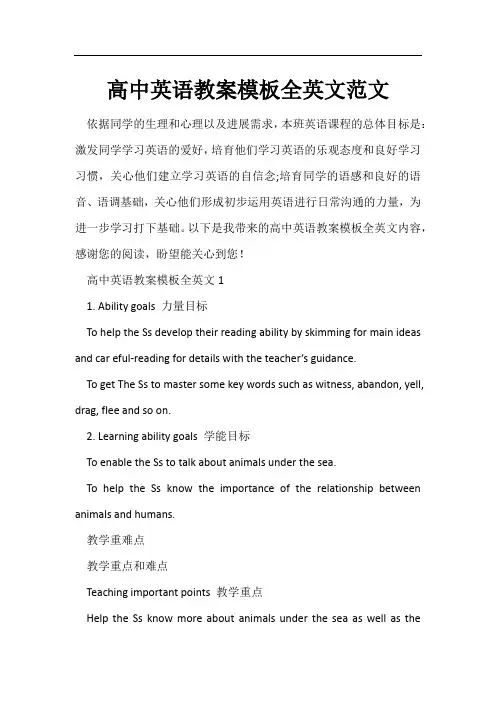
高中英语教案模板全英文范文依据同学的生理和心理以及进展需求,本班英语课程的总体目标是:激发同学学习英语的爱好,培育他们学习英语的乐观态度和良好学习习惯,关心他们建立学习英语的自信念;培育同学的语感和良好的语音、语调基础,关心他们形成初步运用英语进行日常沟通的力量,为进一步学习打下基础。
以下是我带来的高中英语教案模板全英文内容,感谢您的阅读,盼望能关心到您!高中英语教案模板全英文11. Ability goals 力量目标To help the Ss develop their reading ability by skimming for main ideas and car eful-reading for details with the teacher’s guidance.To get The Ss to master some key words such as witness, abandon, yell, drag, flee and so on.2. Learning ability goals 学能目标To enable the Ss to talk about animals under the sea.To help the Ss know the importance of the relationship between animals and humans.教学重难点教学重点和难点Teaching important points 教学重点Help the Ss know more about animals under the sea as well as theanimals’ loyalty and help to human bein gs.Teaching difficult points 教学难点1. Help the Ss get the main idea and some detailed information by fast-reading and careful-reading.2. Help the Ss tell apart from Before, During and After in the story.教学过程Step1. Warming Up : Talk about animals under the sea.1. Have you ever seen some marine animals?2. What have you seen, and where have you seen them?I have seen a/some/many…… in/on/from……amazing marine animals: seal, turtle, dolphin, sea-horse, sea-star, shark, angelfish, jellyfish, lobster, coralStep2. Fast-reading:1. Find out the Background Information of the story : writer, career, writing style, time, place, main character.2. Find out the Main Idea of the passage: What’s the first story mainly about?Step3. Careful-reading:1. Clancy had heard of the killer whales that every year killer whales would help whalers catch baleen whales. Did he believe it at first? When did he believe it was a true anecdote?2. How many paragraphs are there all together in story1? The hunt canbe divided into 3 stages.Stage1: before the hunt: (para. 2-6):Old Tom’s doing: throwing itself out of … and crashing down again… Why? to tell the whalers…, …by the boat…, circling back to …Why? to lead the whalers…Whalers’ reaction: Another whaler __________. George _____ ___ _____ Clancy, and Clancy ______ after him. They __________ the boat and ______ ____into the bay.Stage23: Dur ing and after the hunt: (para. 7-9):Killer whale’s doing: The killers over there are ________ themselves on the top of the whale’s blow-hole to stop it __________; and some others are stopping it _______ out to sea. The killers started ________ between our boat and the whale just like a pack of ____ ___ dogs. When the baleen whale was dead, its body wa s _______ down into the depths of the sea.Whalers’ reaction: The man in the bow of the boat aimed the harpoon at the whale and then let it go to hit the spot.Conclusion: They have amazing relationship. They work as a team Step4 : SummaryWorking at the _______station, I had the chance to _________ a baleen whale being attacked by a ______ of k iller whales.On the afternoon I arrived at the station, as I was __________ myaccommodation, I heard a loud noise coming from the bay. I ran down to the ______ in time to see an enormous animal _________ itself out of the water and then _______________ again. George told me it was Old Tom, who announced there would be a ___________.Using a _________, we could see a baleen whale _______________ by about six killers. Some are ________ themselves on top of the whale’s __________to stop it breathing; and some others are stopping it _______ out to sea. The whalers aimed the ________ at the whale and then let it go to hit the spot. Being badly ________, the whale soon died. Very soon, its body was ________ by the killers down into the _______ of the sea.课后习题课后作业Deal with Exercise 3 in Comprehending . Let the Ss work in groups and do some discussion:As a matter of fact, whales are now an endangered animal. Many people are trying to protect them from being hunted. The last whaling station in Australia closed in 1978. But some countries oppose the ban. An d there are still people who hunt whales. What’s your opinion? Are you for or against the banning whaling? Consider the problem carefully and we’ll have a discussion tomorrow.高中英语教案模板全英文2(1)课题:Friendship(2)教材分析与同学分析:本单元的中心话题是“友情”,几乎全部的内容都是围绕这一中心话题绽开的。
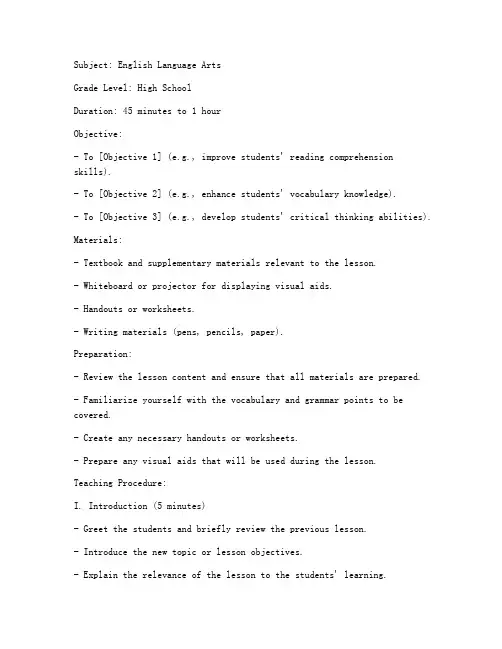
Subject: English Language ArtsGrade Level: High SchoolDuration: 45 minutes to 1 hourObjective:- To [Objective 1] (e.g., improve students' reading comprehension skills).- To [Objective 2] (e.g., enhance students' vocabulary knowledge).- To [Objective 3] (e.g., develop students' critical thinking abilities).Materials:- Textbook and supplementary materials relevant to the lesson.- Whiteboard or projector for displaying visual aids.- Handouts or worksheets.- Writing materials (pens, pencils, paper).Preparation:- Review the lesson content and ensure that all materials are prepared.- Familiarize yourself with the vocabulary and grammar points to be covered.- Create any necessary handouts or worksheets.- Prepare any visual aids that will be used during the lesson.Teaching Procedure:I. Introduction (5 minutes)- Greet the students and briefly review the previous lesson.- Introduce the new topic or lesson objectives.- Explain the relevance of the lesson to the students' learning.II. Warm-Up Activity (10 minutes)- Conduct a brief activity to activate prior knowledge and engage the students.- Example: A quick quiz, a vocabulary game, or a related reading passage.III. Main Content (20 minutes)- Present the main content of the lesson through various activities.- Example:- Reading Comprehension: Have students read a passage and answer comprehension questions.- Vocabulary Building: Introduce new vocabulary and have students practice using them in sentences.- Grammar Practice: Explain and demonstrate the grammar point, then have students practice with exercises.IV. Group Work (10 minutes)- Divide the class into small groups and assign a task related to the lesson.- Example: Discuss a topic, create a presentation, or solve a problem together.V. Individual Work (10 minutes)- Provide students with individual tasks to complete.- Example: Writing a paragraph, filling out a worksheet, or completing a puzzle.VI. Conclusion (5 minutes)- Summarize the main points of the lesson.- Ask students to share their thoughts or experiences related to the topic.- Assign homework or discuss the next lesson.Assessment:- Evaluate students' understanding and participation through quizzes, exercises, and group work.- Collect and review individual work to assess writing and critical thinking skills.Homework:- Assign relevant homework to reinforce the lesson.- Example: Reading a passage, writing a short essay, or completing a grammar exercise.Feedback:- Provide constructive feedback on students' work.- Encourage students to ask questions and seek clarification.Extension Activities:- Suggest additional activities for advanced students or those who need extra help.- Example: Reading a more challenging text, researching a topic, or creating a project.Note:- Adjust the teaching procedure and activities as needed based on the students' needs and responses.- Ensure that all students are engaged and that the lesson is accessible to all learners.---This template can be customized according to the specific needs of the lesson and the level of the students.。
1.高三英语优秀教案模板高中英语阅读课文具有题材广泛、体裁各样、语言知识丰富等特征,是各单元教学的核心部分,也是培养学生阅读能力的主要渠道。
阅读教学传统模式常常是单一的自下而上模式,只是把课文作为单纯向学生传授语法及语言知识的载体,重在老师的讲解,忽视了培养学生的阅读速度和理解能力;传统的阅读理解提问方式也常常停留在对所阅读文章的表层理解层次上。
如何借助这些课文来提高学生的阅读速度、阅读理解能力和语言水平呢?这是一个需要师生互相合作的工作。
在阅读课的课堂教学中,教师应精心设计教学程序,让学生的阅读和讨论交流相互交叉进行,从而使阅读课既达到提高学生阅读水平的效果,又能较好地发挥学生的主观能动性,将接受的信息转变成交际实践的内容。
通过使用交际化的手法进行阅读教学,为提高学生听、说、读、写等综合能力打下坚实的基础。
教学过程由教师、学生、教材、方法四要素组成,这四要素所组成的六对关系只有处于一种和谐的状态,才能实现教学过程的化。
在进行阅读课教学设计时,不能只考虑教师的意志,忽视了学生的主体性。
教师在教学中应激发学生思考,让学生有话可说,并乐于说。
一、设计提问,激发学生的主体思维二、问题设计是英语阅读教学的重要手段,是帮助学生理解、鉴赏文章的切入点。
教师设计问题,要遵循循序渐近的原则三、要把问题建筑在学生的注意力和兴趣之上,服务于全面提高学生素质水平的目标需要。
高中英语课文大多篇幅较长。
课文内容参透了丰富的审美以及科学教育内容。
在这些兼顾知识性、趣味性、思想性的阅读课教学中精心设计既有启发性又能激起学生探讨兴趣的系列问题,可以启迪学生动脑,激发学生思维,培养学生主动学习的习惯。
教师设计问题时,要紧扣教材,层层推进,要具有一定的思想梯度。
在提问、解答的过程中,教师要启发引导,以激活学生的思维XX,帮助学生认知和理解。
二、授之以法,把学习的主动权交给学生要提高学生的素质,就要培养学生的能力。
因此英语阅读教学中要突出“学”字,从让学生“学会”转到培养学生“会学”,授之以法,把学习的主动权交给学生。
高中英语教案万能模板(共7篇)第1篇:少儿英语教案模板少儿英语教案模板一、Teaching Demands and Aims(教学目标)二、Teaching important and difficult point (教学着重)1、words2、sentences3、grammars三、Teaching Aids (教具)四、Teaching procedures(教学过程)Greeting(问候)warm up(热身)Review(复习)New Leon(新课)Step One: Step Two: Step Three: Follow up(叮咛)五、Homework(作业安排)作业的布置一、书面作业1、每节课后教师可适当选择课后习题(书本或课外参考书)及字母作业。
2、低年纪的孩子适合听磁带读课文、画图、连线、写字母等简单作业;每学期两次测试:半期考和期末考试。
3、高年纪的孩子要求抄单词、背单词、背课文等书面作业;每节课前可做适当的听写练习;每次月可做适当的单元测试;期间两次大考:半期考和期末考。
二、磁带作业1、适时安排(条件允许可每周一次):将本周学习的内容录进磁带,下周上交。
2、录制要求:首先让学生和老师打招呼,接着报朗诵单元,然后录作业内容,最后和老师说再见。
(如:Hello! Amanda.I am Go go.This is Unit 11……… Goodbye! Amanda!)3、听音修正:(1)书面记录:边听边把学生的错音登记在学生手册上。
(2)修正过程:A:打招呼,先表彰肯定,后提出错误,注意错音的跟读B:说悄悄话,促进师生感情交流C:提出问题。
D:结束Say:“Good bye! ”三、电话教学1、时间部署:每月两次的电话教学,每生教学时间不超过8分钟。
2、教学内容:(1)本周学习单词及课文的朗诵。
(2)词句的翻译。
(3)疑难解答。
(4)家长的经验交流。
第2篇:高中英语教案高中英语说课模板Ladies and Gentlemen, It’s my great pleasure to be here sharing myleon with you.The content of my leon is《foreign language teaching and research pre》Book ,.let me talk about this leon as the following:一、教材分析:Analysis of the Teaching material二、教学目标:Teaching alms and demands:三、教学重难点:Teaching keys and difficulties:四、教学方法:Teaching methods:五、教学工具:Teaching aids:六、教学过程:Teaching procedures:七、板书设计:Blackboard Design.八教学评价和反思Now,let me talk about the teaching material first.本课时所教的是外研社高一上学期使用的必修2 Mudule6。
[高中英语教案英文模板]英语教案模板全英文第一篇英语教案模板全英文:高中英语全英文说课稿高中英语说课稿范文1I Teaching Aims:1. To develop Ss’ basic skills of listening, speaking, reading and writing. Reading is the focus in this lesson. Reading skills for Ss include (predicting, skimming, scanning and digesting.)2. To encourage Ss to practice, participate, and co-operate in the classroom activities.3. To get Ss to know something about 。
and have a better understanding of the importance of 。
. As for teaching approaches, I think 。
II Teaching Approaches Communicative approach and Computer-Assisted Instruction are to be used in the course of this lesson. And I will try my best to limit TTT, that is, limit Teacher Talking Time and increase STT (Student Talking Time).So during this lesson, emphases are to be laid on:1. Student-centered teaching2. Task-based learning3. Activity-based teaching (individual work; pair work; group work; class work)III Teaching Aids:1. a projector2. a multi-media puter systemThey are for showing Ss some pictures, some audio files, some visual files, some topics or reading tasks.IV Teaching ProcedureStep 1 Warming-up lead-in Activity 1 Free talks (class work) Q1: Who do you think looks coolest in our class? Q2: Do you like him/her? Q3: If so, why? If not, why? 。
Title: Integrating Technology in English Language LearningObjective:- To improve students' ability to use English in real-life situations through technology integration.- To enhance students' listening, speaking, reading, and writing skills.- To encourage critical thinking and collaboration among students.Subject: EnglishGrade Level: 11Duration: 1 hourMaterials:- Interactive whiteboard or computer projector- Computers or tablets with internet access- Headphones or speakers- PowerPoint presentation or digital resources- Handouts (if necessary)- Assessment tools (e.g., quizzes, surveys)Lesson Overview:This lesson aims to introduce students to the use of technology in English language learning. Students will engage in various activities that require them to listen to English audio, watch videos, read articles, and write short essays or summaries.I. Introduction (5 minutes)- Warm-up: Begin with a quick English quiz or a brief discussion on the importance of technology in today's world.- Introduction: Explain the lesson objectives and how technology will be used to achieve them.II. Listening and Speaking (10 minutes)- Activity: Play a short English podcast or a YouTube video related to the topic of the lesson.- Task: Ask students to summarize the main points of the audio/video in their own words.- Group Work: Divide students into small groups and have them discuss their summaries.- Presentations: Each group presents their summary to the class.III. Reading and Writing (15 minutes)- Activity: Provide students with an article or a series of web pages related to the topic.- Task: Students read the material and answer comprehension questions.- Writing: Ask students to write a short essay or summary based on the reading material.IV. Collaboration and Critical Thinking (10 minutes)- Activity: Assign a project that requires students to use technology to research a topic and present their findings.- Task: Students work in pairs or small groups to complete the project.- Group Work: Each group shares their research and presentation with the class.V. Reflection and Assessment (10 minutes)- Reflection: Have students reflect on what they have learned about using technology in English language learning.- Assessment: Provide feedback on the essays or summaries written during the lesson. Use quizzes or surveys to assess students' understanding of the material.Conclusion:- Summary: Recap the main points of the lesson and reinforce the importance of technology in English language learning.- Homework: Assign a related task that involves using technology, such as watching a YouTube video or reading an article in English.Assessment Criteria:- Listening and Speaking: Ability to summarize audio/video content accurately and express thoughts clearly.- Reading and Writing: Understanding of the material, accuracy of the summary or essay, and use of appropriate vocabulary and grammar.- Collaboration and Critical Thinking: Ability to work effectively in a group, critical analysis of the topic, and creativity in the project.Note: This template can be adapted to different topics and lesson objectives. Ensure that the activities are engaging and relevant to the students' interests and learning styles.。
高中英语教案范文3篇Model English teaching plan for senior high school高中英语教案范文3篇前言:英语作为在许多国际组织或者会议上都是必需语言,几乎所有学校选择英语作为其主要或唯一的外语必修课。
英语教学涉及多种专业理论知识,包括语言学、第二语言习得、词汇学、句法学、文体学、语料库理论、认知心理学等内容。
本教案根据英语课程标准的要求和教学对象的特点,将教学诸要素有序安排,确定合适的教学方案的设想和计划、并以启迪发展学生智力为根本目的。
便于学习和使用,本文档下载后内容可按需编辑修改及打印。
本文简要目录如下:【下载该文档后使用Word打开,按住键盘Ctrl键且鼠标单击目录内容即可跳转到对应篇章】1、篇章1:高中英语教案范文2、篇章2:高中英语教案范文3、篇章3:高中英语教案范文篇章1:高中英语教案范文教学目标I. 单词和词组permission, nation,reduce, fetch, compare, therefore, remain, dislik,share, persuade, hardly, go ahead, burn down, compared to, give up, call for, beused to, get into the habit ofII. 日常交际用语1.请求May / Could / Can I do that?I wonder if I can do that.Would / Do you mind if I come earlier?Will you tell me if can go now?2.允许Yes, please. / Of course. / Sure. / Certainly.Go ahead, please.That’s all right. / OK.It’s all right to me.3.拒绝I’m sorry, but it’s not allowed here.You’d better not.I’m afraid not. It’s not right.III.语法复习名词性从句作宾语和表语的用法。
Teaching Plan
I. Topic: eating eggs
II. Target students: fifth grade primary school students
III. Teaching Material: Lesson 13 of Look. Listen and learn
IV. Time: 40min
V. Teaching Objectives:
Language 1. Students should learn the words of lesson 13.
2. Students can read some long sentences of lesson 13.
Ability Students’ listening, speaking, reading and writing skills can be
trained and improved when they complete their tasks by using
the target language.
Affective After learning this lesson, students will know what’s the
difference between British and Chinese in egg-eating and they
will be more interested in western culture as well.
VI. Language focus and difficult points:
1. Focus: This lesson will not only focus on the correct pronunciation of words and
their meanings, but also the imitation of the recordings of those long sentences.
2. Difficult points: Those exaggerated intonation will be a little bit difficult for
students to imitate.
VII. Teaching Aids: an egg, a cup, a mp3
VIII. Teaching Method: task based teaching approach
IX. Teaching Procedure:
Stages/ Timing Activities and methods
Warmimg-up (3 minutes) 1. Let students observe four
pictures and ask what they are
doing.
2. Tell students our mission.
Presentation (10min) 1. Hold an egg and a cup ask
students “ What’s this?”
2. Teach word egg-cup.
3. Teach sentence through mp3.
Play a game (5min) Give prize to students who imitate
the mp3.
Presentation (10min) 1. Teach words.
2. Teach sentences.
3. Let students demonstrate the
sentence.
Play a game (12min) 1. Let students read the three
sentences loudly.
2. Let students demonstrate how
British eat soft boiled eggs
according to these sentences.
Homework (1 minute) 1. Copy the words in the textbook..
2. Follow the recordings of lesson
13.
X. Self-reflection